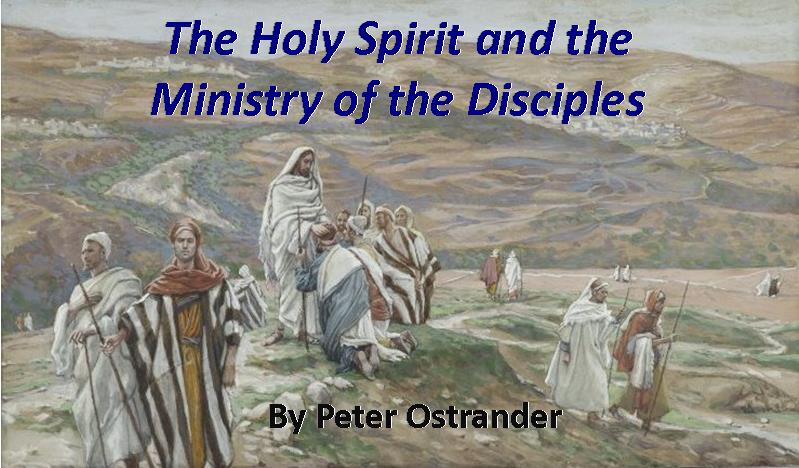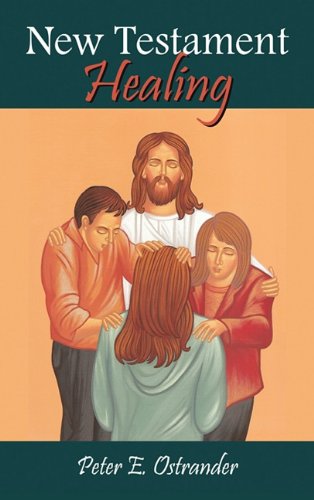The Holy Spirit and the Ministry of the Disciples
Part 2 of an excerpt from Peter Ostrander’s book, New Testament Healing. Read Part 1 in the Winter 2016 issue: “The Holy Spirit and the Ministries of Jesus.”

The Holy Spirit and the Ministry of the Disciples
I am personally interested in finding out whether healings that are carried out by believers follow a pattern similar to that of healings carried out by Jesus, including those associated with the activity of the Holy Spirit. This is not to limit God’s healing activity through Christians who might not identify themselves as Spirit-filled, or as God uses the healing pattern of James 5:14–16 with established elders. I will attempt to use the New Testament to answer these questions.

This article is the second half of chapter 3, “The Holy Spirit and the Ministry of Jesus and His Disciples” from New Testament Healing by Peter E. Ostrander.
In our world of advanced western medicine, complementary or alternate therapies, twelve-step groups, and self-help programs, many people have sought to maintain or improve their health in this life Have you considered another possibility: Christian healing ministry according to the patterns found in the New Testament? If you read the Gospel according to Mark, about 32% of this wonderful narrative up to Jesus’ final week upon earth, is about healing and miracles! Jesus and his first disciples were quite successful. How did they heal the sick? Would a contemporary expression of this ministry be of interest to you? As the good news about Jesus is preached and ordinary Christians pray and minister, people have been healed physically, emotionally, and spiritually, then experience abundant life with Jesus Christ. This book will help you learn more about Christian healing, encourage you to receive ministry, and prepare you to reach out to others.
Purchase New Testament Healing by Peter Ostrander
According to Mark, the earliest Gospel, Jesus sent the twelve apostles into ministry sometime before Peter’s confession of faith at Caesarea Philippi and the transfiguration of Jesus, which is recounted near the midpoint of the Gospel account. The accounts of Jesus sending out the twelve apostles are found in Matthew 10, Mark 6, and Luke 9. Additionally, there is an account of Jesus sending out seventy-two individuals. When I was teaching physics, I always gave my students instructions before they began their experiments, hoping they would pay attention. Likewise, Jesus prepared his twelve apostles before sending them out in advance of his visiting many towns in Israel. Clearly, our relationship with God through his Son Jesus Christ, in truth and spirit, is the basis for any possible Christian ministry.
Before he gives either group practical instructions for the way they are to travel, minister, find accommodations, and deal with the reactions of townspeople, Jesus gives them authority to drive out unclean spirits (demons) and to heal diseases and sickness. Luke indicates that the twelve also received power for this ministry.) They are to go only to the lost sheep of Israel (Matt. 10:6), preach the good news of the kingdom (reign) of God and call people to repentance as they heal the sick, cleanse lepers, drive out demons, and even raise the dead. They are to go out as Jesus’ commissioned representatives or ambassadors, then do the things that Jesus had been doing since his baptism. They go in pairs, without baggage, without money to purchase their own lodging or meals. They rely on the goodwill hospitality of townspeople. While obeying Jesus, they discover that God actually works through them in wonderful ways. Jesus’ own authority, or right to minister, had somehow been transmitted to them, and God’s power is evident as people are healed or set free. This takes place despite their incomplete understanding of who Jesus is or of God’s plan that his Son would die on the cross for their and our sins. One would betray Jesus and then commit suicide, another would deny Jesus, and the rest would flee before being surprised by the Resurrection. Jesus had not yet breathed on them, telling them to “Receive the Holy Spirit” (John 20:22). They had not yet experienced the baptism with the Holy Spirit at Pentecost or the subsequent infillings. Nevertheless, their ministry is successful, and they report to Jesus what they had done (Luke 9:12).
Somewhat later, Jesus appoints seventy-two other people to be sent out (apostled, sent with a mission) two by two as his advance agents to every place and town where he is preparing to go (Luke 10:1). Jesus states that the harvest had been abundant but that the workers are few. He tells them to ask the lord of the harvest to send out workers, then Jesus makes his hearers part of the answer to their own prayers. They are to travel light, accept the first offer of hospitality, proclaim peace (shalom) to the house, and stay there. They are to proclaim the near presence of God’s reign and to heal the sick. If they are not welcomed, they are to wipe the dust from their sandals as a testimony against those who do not welcome them and to warn the unreceptive again of the proximity of God’s kingdom, which requires a response. Rejecting his workers and representatives is equivalent to rejecting Jesus himself.
Category: Spirit, Spring 2016


